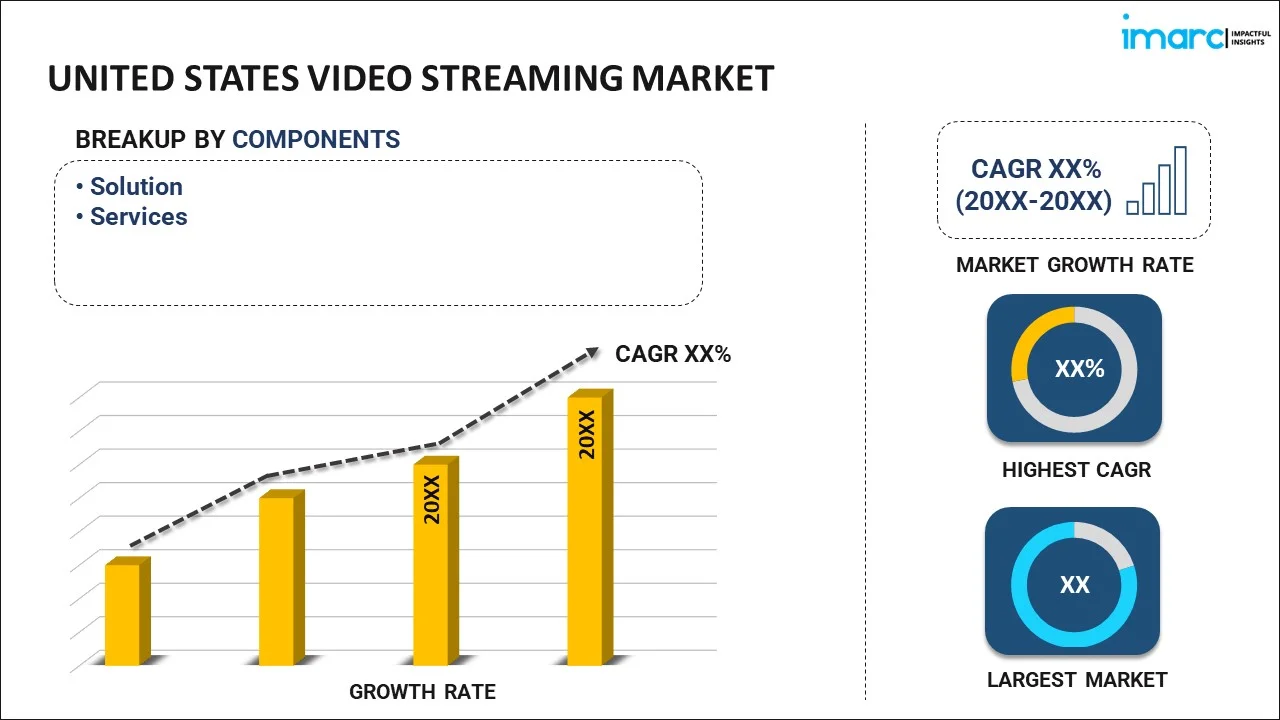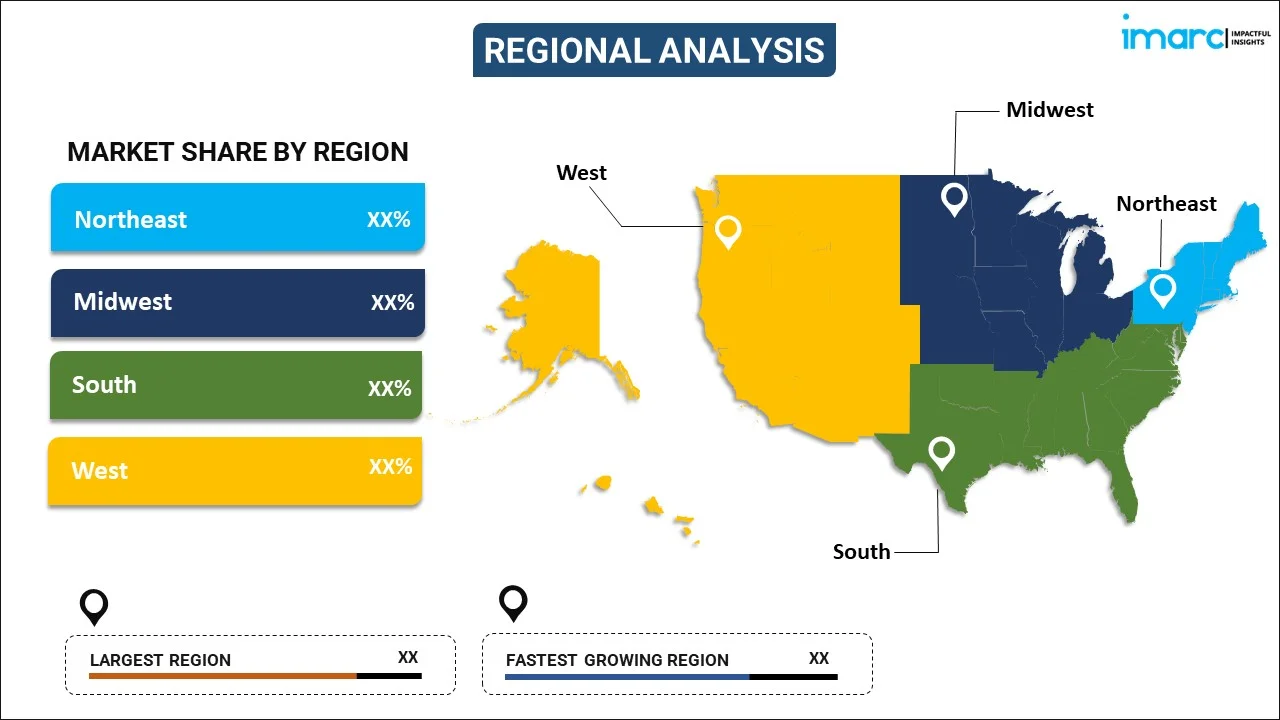
United States Video Streaming Market Report by Component (Solution, Services), Streaming Type (Live/Linear Video Streaming, Non-Linear Video Streaming), Revenue Model (Subscription, Transactional, Advertisement, Hybrid), End User (Personal, Commercial), and Region 2025-2033
Market Overview:
United States video streaming market size is projected to exhibit a growth rate (CAGR) of 18.15% during 2025-2033. The increasing proliferation of smartphones and other mobile devices that has made it convenient for users to access video content anytime, anywhere, is driving the market.
|
Report Attribute
|
Key Statistics
|
|---|---|
|
Base Year
|
2024 |
|
Forecast Years
|
2025-2033 |
|
Historical Years
|
2019-2024
|
| Market Growth Rate (2025-2033) | 18.15% |
Video streaming is a technology that enables the continuous transmission of video content over the internet in real time. Instead of downloading an entire video file before playback, streaming allows viewers to watch videos instantly without the need for storage space. The process involves sending compressed video data as a continuous stream, allowing users to start watching while the remaining content is still being transmitted. This method ensures a smoother and more efficient viewing experience, as users don't have to wait for the entire file to download. Popular streaming platforms, such as Netflix, YouTube, and Hulu, use adaptive streaming techniques to adjust video quality based on the viewer's internet speed, ensuring a seamless playback experience across various devices. Streaming has become a ubiquitous way for people to access a vast array of video content, including movies, TV shows, live events, and more.
United States Video Streaming Market Trends:
The video streaming market in the United States has witnessed unprecedented growth in recent years, primarily driven by the increasing penetration of high-speed internet and the proliferation of smart devices. Firstly, with the regional expansion of broadband infrastructure, consumers now have seamless access to high-speed internet, facilitating the smooth streaming of high-quality video content. Consequently, this has spurred the adoption of video streaming services as users seek convenient and on-demand access to a plethora of entertainment options. Moreover, the ubiquity of smartphones and smart TVs has played a pivotal role in propelling the video streaming market forward. As these devices become more affordable and widely accessible, consumers are embracing the flexibility and convenience of watching videos anytime, anywhere. Additionally, the rise of original content production by streaming platforms has fueled subscriber growth, as exclusive and compelling content becomes a significant driver for customer acquisition and retention. Furthermore, the ongoing shift in consumer preferences from traditional cable TV to on-demand streaming services is expected to drive the video streaming market in the United States during the forecast period.
United States Video Streaming Market Segmentation:
IMARC Group provides an analysis of the key trends in each segment of the market, along with forecasts at the country level for 2025-2033. Our report has categorized the market based on component, streaming type, revenue model, and end user.
Component Insights:

- Solution
- IPTV
- Over-the-top
- Pay TV
- Services
- Consulting
- Managed Services
- Training and Support
The report has provided a detailed breakup and analysis of the market based on the component. This includes solution (IPTV, over-the-top, and pay TV) and services (consulting, managed services, and training and support).
Streaming Type Insights:
- Live/Linear Video Streaming
- Non-Linear Video Streaming
A detailed breakup and analysis of the market based on the streaming type have also been provided in the report. This includes live/linear video streaming and non-linear video streaming.
Revenue Model Insights:
- Subscription
- Transactional
- Advertisement
- Hybrid
The report has provided a detailed breakup and analysis of the market based on the revenue model. This includes subscription, transactional, advertisement, and hybrid.
End User Insights:
- Personal
- Commercial
A detailed breakup and analysis of the market based on the end user have also been provided in the report. This includes personal and commercial.
Regional Insights:

- Northeast
- Midwest
- South
- West
The report has also provided a comprehensive analysis of all the major regional markets, which include Northeast, Midwest, South, and West.
Competitive Landscape:
The market research report has also provided a comprehensive analysis of the competitive landscape in the market. Competitive analysis such as market structure, key player positioning, top winning strategies, competitive dashboard, and company evaluation quadrant has been covered in the report. Also, detailed profiles of all major companies have been provided.
United States Video Streaming Market Report Coverage:
| Report Features | Details |
|---|---|
| Base Year of the Analysis | 2024 |
| Historical Period | 2019-2024 |
| Forecast Period | 2025-2033 |
| Units | Million USD |
| Scope of the Report | Exploration of Historical Trends and Market Outlook, Industry Catalysts and Challenges, Segment-Wise Historical and Future Market Assessment:
|
| Components Covered |
|
| Streaming Types Covered | Live/Linear Video Streaming, Non-Linear Video Streaming |
| Revenue Models Covered | Subscription, Transactional, Advertisement, Hybrid |
| End Users Covered | Personal, Commercial |
| Regions Covered | Northeast, Midwest, South, West |
| Customization Scope | 10% Free Customization |
| Post-Sale Analyst Support | 10-12 Weeks |
| Delivery Format | PDF and Excel through Email (We can also provide the editable version of the report in PPT/Word format on special request) |
Key Questions Answered in This Report:
- How has the United States video streaming market performed so far and how will it perform in the coming years?
- What has been the impact of COVID-19 on the United States video streaming market?
- What is the breakup of the United States video streaming market on the basis of component?
- What is the breakup of the United States video streaming market on the basis of streaming type?
- What is the breakup of the United States video streaming market on the basis of revenue model?
- What is the breakup of the United States video streaming market on the basis of end user?
- What are the various stages in the value chain of the United States video streaming market?
- What are the key driving factors and challenges in the United States video streaming?
- What is the structure of the United States video streaming market and who are the key players?
- What is the degree of competition in the United States video streaming market?
Key Benefits for Stakeholders:
- IMARC’s industry report offers a comprehensive quantitative analysis of various market segments, historical and current market trends, market forecasts, and dynamics of the United States video streaming market from 2019-2033.
- The research report provides the latest information on the market drivers, challenges, and opportunities in the United States video streaming market.
- Porter's five forces analysis assist stakeholders in assessing the impact of new entrants, competitive rivalry, supplier power, buyer power, and the threat of substitution. It helps stakeholders to analyze the level of competition within the United States video streaming industry and its attractiveness.
- Competitive landscape allows stakeholders to understand their competitive environment and provides an insight into the current positions of key players in the market.
Need more help?
- Speak to our experienced analysts for insights on the current market scenarios.
- Include additional segments and countries to customize the report as per your requirement.
- Gain an unparalleled competitive advantage in your domain by understanding how to utilize the report and positively impacting your operations and revenue.
- For further assistance, please connect with our analysts.
 Inquire Before Buying
Inquire Before Buying
 Speak to an Analyst
Speak to an Analyst
 Request Brochure
Request Brochure
 Request Customization
Request Customization




.webp)




.webp)












